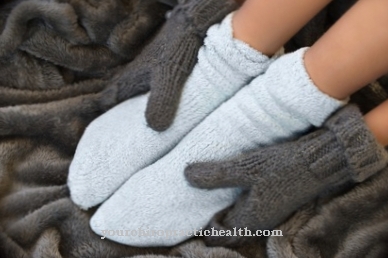Jaundice, also Jaundice or Yellowing called, is a symptom that can occur in several different diseases. It describes the yellowing of the skin, mucous membranes and the conjunctiva of the eye due to an increased concentration of bilirubin.
What is jaundice?

The symptom popularly known as jaundice is also called jaundice by medical professionals. It describes the yellowish discoloration of the skin, mucous membranes and eyes. The jaundice is accompanied by severe itching, as well as nausea and vomiting of greenish-yellow stomach contents.
It is not uncommon for jaundice to be accompanied by abdominal pain, usually on the right, and acid eructations. Fever and a general feeling of illness, diarrhea or stool discoloration may also occur.
In the worst case, it can lead to confusion and changes in personality of the sick person. Jaundice requires immediate medical treatment.
causes
The cause of jaundice is an increase in the concentration of bilirubin, a breakdown product of the blood pigment hemoglobin, in the bloodstream. The jaundice is based on a disturbance in the bilirubin metabolism. The bilirubin, which is normally excreted through the biliary tract, is deposited in the tissue. This becomes visible on the skin and in the eyes. The clinical picture of jaundice develops.
Increased seizures or decreased excretion of bilirubin lead to an increase in the serum concentration in body tissue. This means that a color change first appears on the white dermis of the eye. As the values continue to increase, the yellowish changes can finally also be observed on the skin and mucous membranes. The body fluids and other organs are also affected. The urine can be dark brown, while the stool can be light or white.
The increase in bilirubin in the blood can be caused by three different types. Pre-hepatic jaundice (developing in front of the liver) is caused by the increased breakdown of red blood cells (hemolysis). This is usually due to a blood disorder that causes the decay. Intra-hepatic jaundice can result from inflammation of the liver (hepatitis) or from a tumor in the liver. Hepatitis can be caused, among other things, by viruses, drugs or alcohol abuse.
Post-hepatic jaundice is caused by obstruction of drainage in the biliary tract. The bile that is formed in the liver cannot drain off due to obstacles and the bile backs up (cholestasis) up to the liver. Cholestasis can be caused by gallstones, a narrowing of the biliary tract (stenosis) or tumors.
You can find your medication here
➔ Medicines for jaundice and liver problemsDiseases with this symptom
- Gallstones
- Cholestasis
- Gallbladder inflammation
- hepatitis
- Cirrhosis of the liver
- Liver failure
- Yellow fever
- Gallbladder cancer and bile duct cancer
- Inflammation of the pancreas
Complications
The concept of complication should include the entire clinical picture. In the medical field, complication means another symptom of a disorder or a side effect of a drug, provided that it was used against the disease in question. Complications can therefore arise due to a misdiagnosis or in the course of the medical measure.Jaundice is a common complication of liver or biliary disorders, which are diseases of the digestive system. Jaundice can also indicate additional complications.
Jaundice is caused by the accumulation of bile in the bile duct, triggered by various diseases. Complications usually arise in the physically weakened sufferer. With complicated forms, the underlying disease can lead to death. Jaundice can be a sign of this. To avoid such complications, a clinical examination must be ordered when the first signs appear. Thereafter, the person concerned should be treated in the clinic to avert complications such as jaundice. A plan for the following outpatient therapy for jaundice and the causative disease can be made here. Jaundice is just a symptom, for example in cirrhosis of the liver.
A wholesome diet, avoidance of alcohol and fatty foods as well as regular preventive examinations can prevent jaundice. Sometimes a reduced-calorie diet is necessary. Some drugs are dangerous for the liver and gall bladder, so avoid them in jaundice.
When should you go to the doctor?
When it comes to jaundice, it is important to remember that it is a symptom, not a disease in itself. Most often jaundice is an expression of liver dysfunction. For this reason, a doctor should always be consulted with jaundice.
Liver problems such as liver inflammation, liver cirrhosis, liver tumors and liver cancer can lead to the destruction of this vital organ. What is dangerous with diseases of the liver is that there is often no pain at the beginning. Jaundice can therefore be an important indicator of a liver disorder that requires urgent treatment.
In addition to the liver, a disturbance in the elimination of bile from the gallbladder can cause jaundice. Gallstones, biliary tract infections and bile duct tumors are responsible for this. These ailments are also an essential part of medical treatment.
Jaundice is sometimes caused by an excessive breakdown of red blood cells, the erythrocytes, whereby unprocessed bilirubin is deposited and leads to yellowing. This process also leads to newborn jaundice, which generally resolves on its own because the liver of newborns cannot process bilirubin during the first few days of life. To be on the safe side, a newborn with jaundice should still be presented to a pediatrician.
Doctors & therapists in your area
Treatment & Therapy
Treatment for jaundice depends on the trigger. The therapy of jaundice is therefore closely linked to the causes. The goal is to lower the level of bilirubin in the blood. To do this, the cause of the jaundice must first be found out, as each cause has different treatments.
Gallstones, for example, can be removed using special endoscopes. In some cases, a diseased gallbladder must be surgically removed. If drugs have damaged the liver, the jaundice usually disappears when they are no longer taken. Antiviral agents can help against jaundice caused by viruses.
Pre-hepatic jaundice requires treatment of the underlying blood disease. Depending on the type of illness, this can be time-consuming. In post-hepatic jaundice, getting rid of the cause of the bile congestion is the first priority. A gallstone can sometimes be removed with the help of an endoscopic procedure. A narrowing can also be supplied with a stent under endoscopic conditions. The bile duct is widened and a small grid is used to keep the bile duct open at all times.
The endoscopy of the biliary tract is performed under short-term anesthesia and is uncomplicated if the anatomical conditions are good. For the toxic intra-hepatic cause of jaundice (due to poisons), an immediate abstinence from the drug or alcohol that is causing it is advisable. While weaning off medication is relatively easy with medical supervision, withdrawal from alcohol can be more difficult. In most cases, controlled withdrawal with psychiatric support is necessary. Tumors that cause jaundice should be removed as soon as possible depending on the severity of the disease.
Outlook & forecast
The prognosis, the further course of the disease and the prospect of a cure for jaundice are directly dependent on the cause that causes this symptom. The actual symptom is usually not dangerous. The itching that often accompanies jaundice makes it rather uncomfortable.
However, some underlying diseases that can cause jaundice are dangerous and in the worst case scenario can be fatal. Pancreatic cancer is a dangerous cause of jaundice. If it is possible to remove the tumor, the survival rate is around fifteen percent. In the case of inoperable tumors of the pancreas, however, the chance of a cure is very poor.
Other triggers of jaundice, such as liver inflammation caused by hepatitis A or B viruses, in most cases heal by themselves in a few weeks and therefore have a good prognosis of 95 percent survival rate.
Jaundice, known as jaundice, occurs particularly frequently in newborns. In most cases, however, neonatal jaundice is not caused by a serious cause. After about a week, the symptom heals on its own. It becomes problematic when the jaundice is chronic. In a few cases, jaundice can lead to irreparable organ damage.
You can find your medication here
➔ Medicines for jaundice and liver problemsprevention
A low-fat diet is recommended to prevent jaundice due to the build-up of bile. Eating too greasy will promote the development of gallstones. The use of medication should be taken as directed by the attending physician. Some drugs affect the liver if taken incorrectly or over a long period of time.
In order to avoid a liver attacked or destroyed by alcohol, alcohol should be consumed in moderation or, preferably, not at all. Anything that promotes possible triggers of jaundice, e.g. B. gallstones, liver cirrhosis or hepatitis, also promotes the development of jaundice. A low-fat, high-fiber diet helps prevent gallstones.
A moderate consumption or even a complete renunciation of alcohol protects the liver from damage. In addition, vaccination against hepatitis A or hepatitis B viruses can prevent infection and thus liver damage.
Home remedies & herbs for jaundice
- Strawberry leaves help against jaundice.
You can do that yourself
In the case of jaundice, a doctor rarely prescribes special medication that counteract the typical symptoms. Because of this, it is advisable to do something against jaundice yourself with home remedies. There are numerous home remedies available to provide symptom relief. This particularly includes tea made from fresh strawberry leaves. Mint tea and dandelion tea are also helpful.
Those affected can counteract jaundice by consuming a glass of tomato juice with salt every day. Drinking tea made from dried oregano has also proven its worth. Those affected should pour hot water over them. The pulp of a mashed banana is also helpful. So that it contributes to the relief, those affected should add a little honey.
Established home remedies also include ginger and mint juice and lemon leaf tea. For people who want to treat their jaundice themselves, we recommend freshly squeezed lime juice or beetroot juice with a dash of lemon every day.
Jaundice doesn't have to develop in the first place. Those who reduce their excess weight and eat low-fat meals can prevent jaundice. The reduction in high-carbohydrate food and the avoidance of alcohol are also worth mentioning. Food should not be seasoned too strongly.

























.jpg)


